HIE Team Visits Gills Harbour
24th October 2013
TOP-LEVEL HIGHLANDS & ISLANDS ENTERPRISE TEAM VISITS GILLS HARBOUR IN LATE OCTOBER, 2013.
A top-level team from Highlands and Islands Enterprise, the Scottish Government's North of Scotland jobs agency, visited Gills Harbour and were given a tour of its facilities this week (21.10.13) by the office-bearers of its Canisbay community owners, Gills Harbour Ltd (GHL).
The three-strong delegation to the British mainland's most Northerly port was led by Mr Calum Davidson, HIE's Director of Energy and Low Carbon at the public-sector body's Inverness headquarters.
It included Mr Roy Kirk, HIE's area manager for Caithness & Sutherland and Ms Claire Conway, 'head of infrastructure' at its area office in Thurso, Caithness.
This was Mr Davidson's second visit ; he had pledged to make a return call there during 2013, as the Pentland Firth 'marine electricity' plan prepares to start 'rolling out'.
A year ago, the community-owned harbour company's directors acted on his suggestion that they contact vessel-operating marine engineering contractors, known to be aiming for a commercial role in the development of tidal stream electricity-generation in the Pentland Firth, to gauge their interest in using Gills Harbour, especially if some upgrading works were to be undertaken there.
Several of the latter are led by mariners familiar with the vagrancies of year-round sea conditions in the Firth. They all responded by stating that Gills Harbour would be their first choice as a mainland shore-base in view of its close proximity to the four seabed leases granted for 'tidal energy' purposes by the Crown Estate in 2010, especially if it could be upgraded.
Those concessions all lie under the Firth's narrowest Eastern end, where the tidal streams flow mostly swiftly. All are within 8 miles of Gills Harbour, while MeyGen Ltd's Inner Sound sea-bed lease site lies only 1 to 1.5 miles off the little port's entrance channel.
The harbour company's vice-chairman Mr Clifford Shepherd, of Quoys of Canisbay farm, on the shores of Gills Bay, explained that it was not necessary for the crews and engineers on board such vessels to cross any of the Firth's 'notorious' tide-races, where white-water breaks daily year-round on the appropriate part of the 12.5 hourly tide-cycle, to access those lease sites from Gills Harbour.
This fact adds to the economic importance of the port, as it cannot be duplicated from any other Scottish mainland harbours. It should also improve the comfort of those working on such vessels, and so add to their productivity and in turn help reduce the cost of electricity generation.
On this visit, the HIE team were shown the evidence of substantial-scale sub-surface improvement works done in recent months by the harbour company's lessee Pentland Ferries Ltd, following consent granted last May (2013) by Marine Scotland, the Scottish Government's 'seas management' agency.
This work, being undertaken by its Gills-based 'direct labour squad', involves creating a 100 metres X 100 metres sheltered 'ship turning circle' for vessels drawing up to 4 metres of water, in the lee of its present 116 metre long breakwater berth, so that vessels, including its ferry, can always enter and leave the harbour in forward motion.
This private-sector work, being undertaken without any Government financial help so far, also includes consented plans for a 70 metre long seaward extension, again to be using a recycled former floating dry-dock, to the harbour's main breakwater/berth. The infrastructure unit for this extension is temporarily at St Margaret's Hope, 15 miles away in Orkney, at present.
Pentland Ferries Ltd intends that this extension will be 'offset' from the line of the present breakwater. This is to permit larger 'marine renewables' vessels to be berthed along the quayside, with enough 'sea-room' remaining to permit the company's thrice-daily, year-round scheduled services by its 70-metre catamaran RO:RO ferry Pentalina to continue on her regular berthing course without interruption.
Mr Andrew Banks, managing director of the freight and passenger ferry company, was unable to be present on this occasion, being on a pre-booked family holiday abroad.
The visitors praised Mr Banks's entrepreneurship on hearing from GHL Secretary/treasurer John Green that Pentland Ferries employs up to 15 persons locally, mostly year-round. Those include its pier-master & shore-crews, its 'direct labour' construction team, its 'booking-hall' office manageress and staff, plus the ladies running its cafeteria in its modern Gills Harbour terminal building.
The HIE team asked to be shown the harbour's un-leased Inner Basin, which Gills Harbour Ltd aims itself to have developed, so that it can handle standard 'multi-cat' 25 metre long 'marine renewables support vessels', at all states of the tide, with sheltered berthing.
Several of those powerful modern little ships, which typically draw between 3 and 3.5 metres of water and can serve as tugs, cabling support craft and be used for other multi-purpose marine-engineering tasks, have used Gills Harbour for Pentland Firth tidal-energy reasons, since Mr Davidson's previous visit in 2012.
Those include the C-Salvor, C-Odyssey and Orcadia, owned by Orkney-based companies.
Those have been demonstrating their capabilities in recent times at the European Marine Energy Centre (EMEC) tidal site off Eday, Orkney.
Several prototype 1 MW to 1.5 MW tidal turbines, of the type and design that will be used to generate electricity in the Pentland Firth from 2015 onwards, are currently undergoing prolonged EMEC sea-trials on a seabed similar to that found in its Inner Sound, between Canisbay and the island of Stroma. Water-depths, weather and sea-conditions are also broadly comparable between the two locations.
Afterwards, Mr Bill Mowat, GHL's chairman said: ' We hope that the visitors have gone way with a good impression of the important role that this port can play in helping to ensure that Pentland Firth electricity has a long-term future as part of the local economy. This should be a 'green energy' matter of national and international significance as well. The visitors told us that there was already plenty of evidence that there will be wide-spread interest in the first turbine deployments in the Inner Sound and that it was important that the area is seen to rise to the challenge'.
Last week Gills Harbour had a site meeting with Mr Eann Sinclair, programme manager with the Caithness and North Sutherland Regeneration Partnership, while earlier this year the Highland Council's convener Councillor Jimmy Gray, planning chief Dr Stuart Black, Council leader Councillor Drew Hendry and several other senior Councillors had guided visits there.
Due to visit Gills Harbour soon is Mr John Robertson, Senior Manager (Wave & Tidal) with the Crown Estate's main Scottish office in Edinburgh.
PHOTO
Picture shows (left to right) Mr Roy Kirk; John Green, Bill Mowat; Calum Davidson and Cliff shepherd at Gills Harbour's South Quay.
Related Businesses
Related Articles
Three Cats At Gills Harbour
Two catamaran work-boats berthed at Gills Harbour this week with the trans-Pentlnd ferry MV Alfred, also a catamaran, in the background. The larger workboat is MPC Athenia which was being used as a floating base or ROVs - remote underwater vessels, for detailed inspections on the three turbines operating at the MeyGen demonstration subsea site one and a half miles off Gills Harbour.
GILLS HARBOUR Ltd ANNUAL GENERAL MEETING
GILLS HARBOUR Ltd - ANNUAL GENERAL MEETING at JOHN O'GROATS VILLAGE HALL, MONDAY JUNE 13th @ 7.30 PM. GILLS HARBOUR IS THE ONLY OFFICIALLY-RECOGNISED 'ECONOMIC DEVELOPMENT AREA' IN NE CAITHNESS.Latest Boats At Gills Harbour For Work At Meygen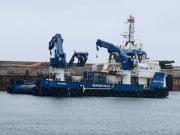
£10 million 'Isle of Jura' temporarily based at Gills Harbour in Far North of Scotland for her crew's debut tasks in the tidal-stream electricity field at the MeyGen sub-sea site, one mile off the little Caithness's port entrance channel. One of the UK's most modern marine renewables service vessels made her debut calls at community-owned Gills Harbour, near John O'Groats, over the 2021 Spring Equinoctial weekend.
Busy Gills Harbour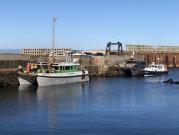
Its been a busy few days at local community-owned Gills Harbour ..... sometimes in suberb sunny weather as here ...
Energy Developments Continue at Gills Harbour and the Pentland Firth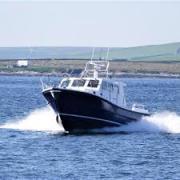
The company behind the world-leading tidal-stream prototype power plant in the Pentland Firth's Inner Sound is set to start manufacturing a new-style turbine that is hopes will reduce the project's generating costs. Simec Atlantis Energy (SAE) and a privately-owned specialist engineering firm from Spain's Bay of Biscay coastline have jointly been conducting 'research and development' (R& D) on the project for almost a year and are now ready to give it the go-ahead.
New Generation of office-bearers set to step up at Gills Harbour Ltd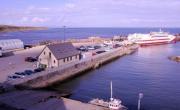
A new generation of younger local folk look set to take over the reins of running Gills Harbour Ltd, the local company that owns and operates the busy little port on the shores of the Pentland Firth's Inner Sound that holds its AGM this Saturday (10.10.20) morning at 10:00 am. The influx of younger blood comes after two key directors of the group that had run 'Canisbay's Peoples Port' both announced their retirement from office, whilst another Gills Harbour Ltd (GHL) office-bearer has declined to seek re-election.
MV Alfred And MV Pentalina Together At Gills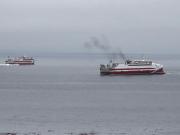
An 'old friend' returns to Gills Bay after an absence of manymonths. The 2,400 tonne 70 m.
Normand Cutter, The Norwegian-owned Offshore Construction Vessel at Gills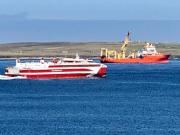
Here is the Normand Cutter, the Norwegian-owned offshore construction vessel that has been the base for works on Simec Atlantis Energy's (SAE's) MeyGen site in the Pentland Firth's Inner Sound, off Gills Bay during the current neap-tide sequence, that has lasted most of the week commencing 11.08.20. Picture by retired C of S Kirk Minister the Rev Lyall Rennie, who lives at Lower Warse, Canisbay, on the shores of Gills Bay..
New Ferry For Pentland Ferries Arrives Safely
Scotland's most modern + environmentally-friendly, fuel-efficient ROPAX ferry ship rge MV Alfred, arrived AM today (Wed 09.10.19 at St Margarets Hope. The boat went round to Kirkwall immediately at the end of 9,000+ miles voyage from the Strategic Marine yard near Ho Chi Minh city (ex.
Gills Harbour Ltd Awards Contract To Local Firm
Gills Harbour Ltd, the community-owned body that owns & operates the busy little port on Caithness's North Coast, has awarded a remedial contract to a Wick-based company. The deal, won in a competitive tender, has gone to builders/civil engineers Messrs GMR Henderson Ltd, of Martha Terrace in Wick.
